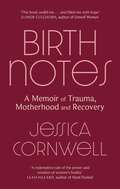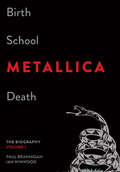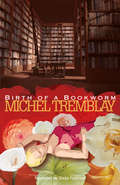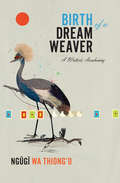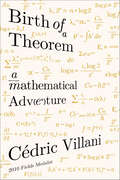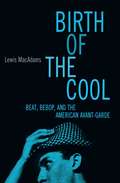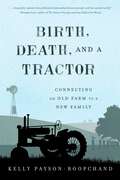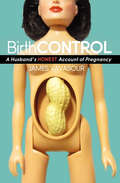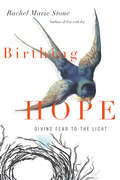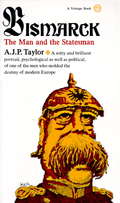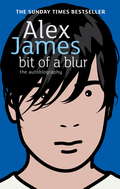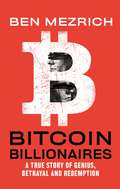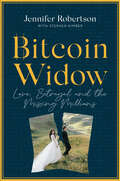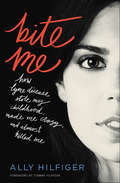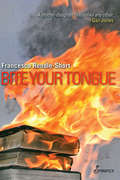- Table View
- List View
Birth Notes: A Memoir of Recovery
by Jessica Cornwell'I SAVOURED EVERY WORD' ABI DARÉ A REDEMPTIVE TALE OF THE POWER AND WISOM OF WOMEN'S BODIES' LEAH HAZARD'MAGNIFICENT: A WORK OF TRUTH' SUSIE ORBACH'FILLED ME WITH HOPE' DR ELINOR CLEGHORN'SO MANY WOMEN WILL FEEL LESS ALONE AFTER READING THIS BOOK' KATIE WARD Following the birth of her first children, twin boys, Jessica Cornwell collapsed in a fever. Rushed back to hospital, she was initially dismissed, before a life-threatening infection was diagnosed. Alone, recovering, watching her body bruise and break, a curious thing happened: she stopped feeling.At home, the numbness remained. Nursing her boys through jaundice, learning to breastfeed, slowly re-emerging into a world where other mothers seemed to cope, Jessica hid her secret - she felt no love, only fear. Worse, vivid memories began to surface, of moments in her past she thought buried.Jessica began to name, one by one, the shadows that returned to haunt her first year as a mother. And in claiming back the words, she fought to claim back her life and the love she bore her young family.Birth Notes is the story - luminous, breathtaking and courageous - of forging a self from fragments. With eloquent rage and searing honesty, it speaks for the unvoiced and shines a light on maternal mental health. It is the love story of a mother for her children and a woman for herself.
Birth Notes: A Memoir of Recovery
by Jessica Cornwell'I SAVOURED EVERY WORD' ABI DARÉ A REDEMPTIVE TALE OF THE POWER AND WISOM OF WOMEN'S BODIES' LEAH HAZARD'MAGNIFICENT: A WORK OF TRUTH' SUSIE ORBACH'FILLED ME WITH HOPE' DR ELINOR CLEGHORN'SO MANY WOMEN WILL FEEL LESS ALONE AFTER READING THIS BOOK' KATIE WARD Following the birth of her first children, twin boys, Jessica Cornwell collapsed in a fever. Rushed back to hospital, she was initially dismissed, before a life-threatening infection was diagnosed. Alone, recovering, watching her body bruise and break, a curious thing happened: she stopped feeling.At home, the numbness remained. Nursing her boys through jaundice, learning to breastfeed, slowly re-emerging into a world where other mothers seemed to cope, Jessica hid her secret - she felt no love, only fear. Worse, vivid memories began to surface, of moments in her past she thought buried.Jessica began to name, one by one, the shadows that returned to haunt her first year as a mother. And in claiming back the words, she fought to claim back her life and the love she bore her young family.Birth Notes is the story - luminous, breathtaking and courageous - of forging a self from fragments. With eloquent rage and searing honesty, it speaks for the unvoiced and shines a light on maternal mental health. It is the love story of a mother for her children and a woman for herself.
Birth School Metallica Death, Volume 1: The Biography
by Paul Brannigan Ian WinwoodThere has never been a hard rock band like Metallica. The California quartet has sold more than 100 million albums worldwide, won nine Grammy Awards, and had five consecutive albums hit number one on the Billboard charts. But Metallica's story, epic in scope, is a tale about much more than sales figures and critical acclaim, and their journey from scuzzy Los Angeles garages to the world's most storied stadiums has been dramatic and painful, their gigantic successes often shot through with tension, tragedy, loss, and controversy.Birth School Metallica Death is the definitive story of the most significant rock band since Led Zeppelin. Volume 1 covers the band's formation up to their breakthrough eponymous fifth album, aka "The Black Album." The intense and sometimes fraught relationship between aloof-yet-simmering singer, chief lyricist, and rhythm guitarist James Hetfield and the outspoken and ambitious drummer Lars Ulrich is the saga's emotional core. Their earliest years saw the release of three unimpeachable classics-Kill 'Em All, Ride the Lightning, and Master of Puppets-genre-defining masterpieces that took hard rock to a new level, both artistically and commercially. During these tumultuous times, the band persevered through line-up changes when guitarist Dave Mustaine was replaced by Kirk Hammet, and their bass player, the beloved Cliff Burton, was tragically killed in a bus crash while on tour in Europe.But it was the breakthrough of ...And Justice for All that rent the fabric of the mainstream, hitting the top of the charts without benefit of radio airplay or the then-crucial presence on MTV. And finally in 1991, with the release of their fifth studio album, nicknamed "The Black Album," Metallica hit the next level-five hit singles including their best-known songs "Enter Sandman" and "Nothing Else Matters"-and their first album atop the Billboard charts.In Birth School Metallica Death, veteran music journalists and Metallica confidants Paul Brannigan and Ian Winwood detail this meteoric rise to international fame in an epic saga of family, community, self-belief, the pursuit of dreams, and music that rocks. Told through first-hand interviews with the band and those closest to them, the story of Metallica's rise to the mainstream has never been so vividly documented.
Birth of a Bookworm
by Michel Tremblay Sheila FischmanIn Birth of a Bookworm, Michel Tremblay takes the reader on a tour of the books that have had a formative influence on the birth and early development of his creative imagination; the physical and emotional world of his childhood is celebrated as the fertile ground on which his new, vivid way of seeing and imagining is built.
Birth of a Dream Weaver: A Writer's Awakening
by Ngugi Wa Thiong'OBirth of a Dream Weaver charts the very beginnings of a writer's creative output. In this wonderful memoir, Kenyan writer Ngugi wa Thiong'o recounts the four years he spent in Makerere University in Kampala, Uganda--threshold years where he found his voice as a playwright, journalist, and novelist, just as Uganda, Kenya, Congo, and other countries were in the final throes of their independence struggles.James Ngugi, as he was known then, is haunted by the emergency period of the previous decade in Kenya, when his friends and relatives were killed during the Mau Mau Rebellion. He is also haunted by the experience of his childhood in a polygamous family and the brave break his mother made from his father's home. Accompanied by these ghosts, Ngugi begins to weave stories from the fibers of memory, history, and a shockingly vibrant and turbulent present.What unfolds in this moving and thought-provoking memoir is both the birth of one of the most important living writers--lauded for his "epic imagination" (Los Angeles Times)--and the death of one of the most violent episodes in global history.
Birth of a Theorem: A Mathematical Adventure
by Cédric VillaniIn 2010, French mathematician Cédric Villani received the Fields Medal, the most coveted prize in mathematics, in recognition of a proof which he devised with his close collaborator Clément Mouhot to explain one of the most surprising theories in classical physics. Birth of aTheorem is Villani's own account of the years leading up to the award. It invites readers inside the mind of a great mathematician as he wrestles with the most important work of his career.But you don't have to understand nonlinear Landau damping to love Birth of aTheorem. It doesn't simplify or overexplain; rather, it invites readers into collaboration. Villani's diaries, emails, and musings enmesh you in the process of discovery. You join him in unproductive lulls and late-night breakthroughs. You're privy to the dining-hall conversations at the world's greatest research institutions. Villani shares his favorite songs, his love of manga, and the imaginative stories he tells his children. In mathematics, as in any creative work, it is the thinker's whole life that propels discovery—and with Birth of aTheorem, Cédric Villani welcomes you into his.
Birth of the Cool
by Lewis MacadamsMiles Davis and Juliette Greco, Jackson Pollock and Jack Kerouac, Marlon Brando and Bob Dylan and William Burroughs. What do all these people have in common? Fame, of course, and undeniable talent. But most of all, they were cool. Birth of the Cool is a stunningly illustrated, brilliantly written cultural history of the American avant-garde in the 1940s and 1950s -- the decades in which cool was born. From intimate interviews with cool icons like poet Allen Ginsberg, bop saxophonist Jackie McLean, and Living Theatre cofounder Judith Malina, award-winning journalist and poet Lewis MacAdams extracts the essence of cool. Taking us inside the most influential and experimental art movements of the twentieth century -- from the Harlem jazz joints where Dizzy Gillespie and Charlie Parker invented bebop to the back room at Max's Kansas City when Andy Warhol was holding court to backstage at the Newport Folk Festival the night Bob Dylan went electric, from Surrealism to the Black Mountain School to Zen -- MacAdams traces the evolution of cool from the very fringes of society to the mainstream. Born of World War II, raised on atomic-age paranoia, cast out of the culture by the realities of racism and the insanity of the Cold War, cool is now, perversely, as conventional as you can get. Allen Ginsberg suited up for Gap ads. Volvo appropriated a phrase from Jack Kerouac's On the Road for its TV commercials. How one became the other is a terrific story, and it is presented here in a gorgeous package, rich with the coolest photographs of the black-and-white era from Robert Doisneau, Henri Cartier-Bresson, Man Ray, and many others. Drawing a direct line between Lester Young wearing his pork-pie hat and his crepe-sole shoes staring out his hotel window at Birdland to the author's three-year-old daughter saying "cool" while watching a Scooby-Doo cartoon at the cusp of a new millennium, Birth of the Cool is a cool book about a hot subject...maybe even the coolest book ever.
Birth, Death, and a Tractor: Connecting An Old Farm To a New Family
by Kelly Payson-RoopchandOnce there were no stone walls. For the fiercely idealistic Yankee homesteader, a small family farm was worth fighting for, and the rocky soil yielded far more than walls. Cleared and plowed, it fed a family and provided a living. Oxen gave way to horses, horses to tractors, and still the farm persisted and the family persevered, each generation overcoming the challenges of their day. Two hundred years later, the farm, ever generous in its rewards, has not changed; but society has shifted, forgetting its connection to the land that nourishes us. It is time we remembered. Birth, Death and a Tractor is the story of a small family farm in Somerville, Maine, from its settling in the early 1800s to its perilous transfer to a new farm family in 2008. Chronicling the history of seven generations, it is a reminder of the role small farms have played in our national and family histories, and a challenge to find innovative ways to re-connect our communities to this rich but threatened resource.
BirthCONTROL: A Husband's Honest Account of Pregnancy
by James VavasourIn this heartfelt and hilarious memoir, a father recounts his many trials and occasional triumphs during he and his wife&’s first pregnancy, week by week. More than four million blissfully ignorant American men are thrust into fatherhood every year, yet these men rarely know what to expect in those crucial first nine months. In BirthCONTROL, author and father James Vavasour offers a real-time, week-by-week account of his journey from pursuing the perfect pregnancy to learning to let go of control. James documented his experiences as they happened in order to capture them in all their wonder, neuroses, and panic. This rare, honest, and unmoderated male perspective on pregnancy will be educational for any couple thinking of starting a family. For those already pregnant, it is a funny, relatable, and often neurotic vision of the day-to-day struggles encountered during this profoundly hormonal time in a couple&’s life. If you&’ve ever had to settle on a baby&’s name or the color of a nursery, be publicly humiliated during birthing classes, or run the obstacle course otherwise known as a grocery store with someone days away from delivery, you&’ll understand.
Birthday
by César AiraBirthday is among the very best of Aira—it will surprise readers new to his work, and will deeply satisfy his many fans Before you know it you are no longer young, and by the way, while you were thinking about other things, the world was changing—and then, just as suddenly you realize that you are fifty years old. Aira had anticipated his fiftieth—a time when he would not so much recall years past as look forward to what lies ahead—but the birthday came and went without much ado. It was only months later, while having a somewhat banal conversation with his wife about the phases of the moon, that he realized how little he really knows about his life. In Birthday Aira searches for the events that were significant to him during his first fifty years. Between anecdotes ,and memories, the author ponders the origins of his personal truths, and meditates on literature meant as much for the writer as for the reader, on ignorance, knowledge, and death. Finally, Birthday is a little sad, in a serene, crystal-clear kind of way, which makes it even more irresistible.
Birthing Hope: Giving Fear to the Light
by Rachel Marie StoneLibrary Journal - Best Books of 2018 "To bring anything new into the world is to open one’s self and therefore to take on risk, to contaminate oneself with the other, to be made vulnerable. This requires not just courage but many things, among them faith, hope, help, companionship, grace—in a word, love." While living in one of the world's most impoverished countries, Rachel Marie Stone unexpectedly caught a baby without wearing gloves, drenching her bare hands with HIV-positive blood. Already worried about her health and family, Stone grappled anew with realities of human suffering, global justice, and maternal health. In these reflections on the mysteries of life and death, Stone unpacks how childbirth reveals our anxieties, our physicality, our mortality. Yet birth is a profoundly hopeful act of faith, as new life is brought into a hurting world that groans for redemption. God becomes present to us as a mother who consents to the risk of love and lets us make our own way in the world, as every good mother must do.
Bishop Von Galen: German Catholicism and National Socialism
by Beth A. Griech-PolelleIn January 1937 several German Catholic cardinals and bishops, including Bishop Clemens August Graf von Galen, traveled to Rome to ask Pope Pius XI to issue a public statement about the perils faced by Catholics in Nazi Germany. The German clergymen drafted what later came to be known as the papal encyclical Mit brennender Sorge.
Bishop of the Resistance: The Life of Eivind Berggrav, Bishop of Oslo
by Edwin RobertsonThe role played by the Bishop of Oslo, especially during the Second World War.
Bishops, Clerks, and Diocesan Governance in Thirteenth-Century England
by Michael BurgerThis book investigates how bishops deployed reward and punishment to control their administrative subordinates in thirteenth-century England. Bishops had few effective avenues available to them for disciplining their clerks, and rarely pursued them, preferring to secure their service and loyalty through rewards. The chief reward was the benefice, often granted for life. Episcopal administrators' security of tenure in these benefices, however, made them free agents, allowing them to transfer from diocese to diocese or even leave administration altogether; they did not constitute a standing episcopal civil service. This tenuous bureaucratic relationship made the personal relationship between bishop and clerk more important. Ultimately, many bishops communicated in terms of friendship with their administrators, who responded with expressions of devotion. Michael Burger's study brings together ecclesiastical, social, legal, and cultural history, producing the first synoptic study of thirteenth-century English diocesan administration in decades. His research provides an ecclesiastical counterpoint to numerous studies of bastard feudalism in secular contexts.
Bismarck: The Man and the Statesman (Penguin Classic Biography Ser.)
by A. J. P. TaylorA re-evaluation of Bismarck's motives and methods, focusing on the chancellor's rise to power in the 1860's and his removal from office in 1890.
Bit Of A Blur: The Autobiography
by Alex JamesI was the Fool-king of Soho and the number-one slag in the Groucho Club, the second drunkest member of the world's drunkest band. This was no disaster, though. It was a dream coming true.'For Alex James, music had always been a door to a more eventful life. But as bass player of Blur - one of the most successful British bands of all time - his journey was more exciting and extreme than he could ever have predicted. In Bit of a Blur he chronicles his journey from a slug-infested flat in Camberwell to a world of screaming fans and private jets - and his eventual search to find meaning and happiness (and, perhaps most importantly, the perfect cheese), in an increasingly surreal world.
Bit Of A Blur: The Autobiography
by Alex JamesFor Alex James, music had always been a door to a more exciting life: a way to travel, meet new people and, hopefully, pick up girls. But as bass player of Blur - one of the most successful British bands of all time - his journey was more exciting and extreme than he could ever have predicted. Success catapulted him from a slug-infested squat in Camberwell to a world of private jets and world-class restaurants. As 'the second drunkest member of the world's drunkest band' life was always chaotic, but Alex James retained a boundless enthusiasm and curiosity at odds with his hedonistic lifestyle. From nights in the Groucho with Damien Hirst, to dancing to Sister Sledge with Bjork, to being bitten on the nose by the lead singer of Iron Maiden, he offers a fascinating and hilarious insight into the world of celebrity. At its heart, however, A BIT OF A BLUR is the picaresque tale of one man's search to find meaning and happiness in an increasingly surreal world. Pleasingly unrepentant but nonetheless a reformed man, Alex James is the perfect chronicler of his generation - witty, frank and brimming with joie de vivre. A BIT OF A BLUR is as charming, funny and deliciously disreputable as its author.
Bit of a Blur: The Autobiography
by Alex JamesI was the Fool-king of Soho and the number-one slag in the Groucho Club, the second drunkest member of the world's drunkest band. This was no disaster, though. It was a dream coming true.'For Alex James, music had always been a door to a more eventful life. But as bass player of Blur - one of the most successful British bands of all time - his journey was more exciting and extreme than he could ever have predicted. In Bit of a Blur he chronicles his journey from a slug-infested flat in Camberwell to a world of screaming fans and private jets - and his eventual search to find meaning and happiness (and, perhaps most importantly, the perfect cheese), in an increasingly surreal world.
Bitcoin Billionaires: A True Story of Genius, Betrayal and Redemption
by Ben MezrichFrom Ben Mezrich, the New York Times bestselling author of The Accidental Billionaires and Bringing Down the House, comes Bitcoin Billionaires - the fascinating story of brothers Tyler and Cameron Winklevoss's big bet on crypto-currency and its dazzling pay-off.Ben Mezrich's 2009 bestseller The Accidental Billionaires is the definitive account of Facebook's founding - and the basis for the Academy Award-winning film The Social Network. Two of the story's iconic characters are Harvard students Tyler and Cameron Winklevoss: identical twins, Olympic rowers, and legal foils to Mark Zuckerberg. Bitcoin Billionaires is the story of the brothers' redemption and revenge in the wake of their epic legal battle with Facebook - and the first great book from the world of bitcoin.Planning to start careers as venture capitalists, the brothers quickly discover that no one will take their money for fear of alienating Zuckerberg. While nursing their wounds in Ibiza, they accidentally run into a shady character who tells them about a brand new idea: cryptocurrency. Immersing themselves in what is then an obscure and sometimes sinister world, they begin to realize "crypto" is, in their own words, "either the next big thing or total bulls--t." There's nothing left to do but make a bet.From the Silk Road to the halls of the Securities and Exchange Commission to the Facebook boardroom, Bitcoin Billionaires will take us on a wild and surprising ride while illuminating a tantalizing economic future. On November 26th, 2017, the Winklevoss brothers became the first bitcoin billionaires. Here's the story of how they got there - as only Ben Mezrich could tell it.
Bitcoin Billionaires: A True Story of Genius, Betrayal and Redemption
by Ben MezrichFrom Ben Mezrich, the New York Times bestselling author of The Accidental Billionaires and Bringing Down the House, comes Bitcoin Billionaires - the fascinating story of brothers Tyler and Cameron Winklevoss's big bet on crypto-currency and its dazzling pay-off.Ben Mezrich's 2009 bestseller The Accidental Billionaires is the definitive account of Facebook's founding - and the basis for the Academy Award-winning film The Social Network. Two of the story's iconic characters are Harvard students Tyler and Cameron Winklevoss: identical twins, Olympic rowers, and legal foils to Mark Zuckerberg. Bitcoin Billionaires is the story of the brothers' redemption and revenge in the wake of their epic legal battle with Facebook - and the first great book from the world of bitcoin.Planning to start careers as venture capitalists, the brothers quickly discover that no one will take their money for fear of alienating Zuckerberg. While nursing their wounds in Ibiza, they accidentally run into a shady character who tells them about a brand new idea: cryptocurrency. Immersing themselves in what is then an obscure and sometimes sinister world, they begin to realize "crypto" is, in their own words, "either the next big thing or total bulls--t." There's nothing left to do but make a bet.From the Silk Road to the halls of the Securities and Exchange Commission to the Facebook boardroom, Bitcoin Billionaires will take us on a wild and surprising ride while illuminating a tantalizing economic future. On November 26th, 2017, the Winklevoss brothers became the first bitcoin billionaires. Here's the story of how they got there - as only Ben Mezrich could tell it.
Bitcoin Billionaires: A True Story of Genius, Betrayal, and Redemption
by Ben MezrichFrom Ben Mezrich, the New York Times bestselling author of The Accidental Billionaires and Bringing Down the House, comes Bitcoin Billionaires--the fascinating story of brothers Tyler and Cameron Winklevoss's big bet on crypto-currency and its dazzling pay-off. Ben Mezrich's 2009 bestseller The Accidental Billionaires is the definitive account of Facebook's founding and the basis for the Academy Award–winning film The Social Network. Two of the story's iconic characters are Harvard students Tyler and Cameron Winklevoss: identical twins, Olympic rowers, and foils to Mark Zuckerberg. Bitcoin Billionaires is the story of the brothers’ redemption and revenge in the wake of their epic legal battle with Facebook. Planning to start careers as venture capitalists, the brothers quickly discover that no one will take their money after their fight with Zuckerberg. While nursing their wounds in Ibiza, they accidentally run into an eccentric character who tells them about a brand-new idea: cryptocurrency. Immersing themselves in what is then an obscure and sometimes sinister world, they begin to realize “crypto” is, in their own words, "either the next big thing or total bulls--t." There’s nothing left to do but make a bet. From the Silk Road to the halls of the Securities and Exchange Commission, Bitcoin Billionaires will take us on a wild and surprising ride while illuminating a tantalizing economic future. On November 26, 2017, the Winklevoss brothers became the first bitcoin billionaires. Here’s the story of how they got there—as only Ben Mezrich could tell it.
Bitcoin Widow: Love, Betrayal and the Missing Millions
by Stephen Kimber Jennifer RobertsonShe met the man of her dreams and suddenly had it all. Then, in one fateful night, she lost everything, and the nightmare beganJennifer Robertson was working hard to build a life for herself from the ashes of her first marriage. Still only twenty-six, she swiped right on a dating app and met Gerry Cotten, a man she would not normally have considered—too young and not her type—but found she’d met her match. Eccentric but funny and kind, Cotten turned out to be a bitcoin wizard who quickly amassed substantial wealth through his company, Quadriga. The couple travelled the world, first class all the way, while Cotten worked on his multitude of encrypted laptops. Then, while the couple was on their honeymoon in India, opening an orphanage in their name, Gerry fell ill and died in a matter of hours. Jennifer was consumed by grief and guilt, but that was only the beginning. It turned out that Gerry owed $250 million to Quadriga customers, and all the passwords to his encrypted virtual vaults, hidden on his many laptops, had died with him. Jennifer was left with more than one hundred thousand investors looking for their money, and questions, suspicions and accusations spiralling dangerously out of control. The Quadriga scandal touched off major investment and criminal investigations, not to mention Internet rumours circulating on dark message boards, including claims that Gerry had faked his own death and that his wife was the real mastermind behind a sophisticated sting operation. While Jennifer waited for a dead man’s switch e-mail that would probably never come, it became clear that Cotten had gambled away about $100 million of the funds entrusted to him for investment in his many schemes, leaving Robertson holding the bag. Bitcoin Widow is Catch Me If You Can meets a widow betrayed, a life of fairy-tale romance and private jets torched by duplicity, as Jennifer Robertson tries to reset her life in the wake of one of the biggest investment scandals of the digital age.
Bite Me: How Lyme Disease Stole My Childhood, Made Me Crazy, and Almost Killed Me
by Ally HilfigerAlly was at a breaking point when she woke up in a psych ward at the age of eighteen. She couldn't put a sentence together, let alone take a shower, eat a meal, or pick up a phone. What had gone wrong? In recent years, she had produced a feature film, a popular reality show for a major network, and had acted in an off-Broadway play. But now, Ally was pushed to a psychotic break after struggling since she was seven years old with physical symptoms that no doctor could explain; everything from joint pain, to night sweats, memory loss, nausea, and brain fog. A doctor in the psych ward was finally able to give her the answers her and her family had desperately been searching for, and the diagnosis that all the previous doctors had missed. She learned that she had Lyme disease-and finally had a breakthrough.What she didn't know was that this diagnosis would lead her down some of the most excruciating years of her life before beginning her journey to recovery from eleven years of misdiagnosis and physical pain. She would need to find her courage to heal physically, mentally, and emotionally, and become the survivor she is today.Set against the backdrop of the fast-paced fashion and entertainment industries, Bite Me shares the heartbreaking and hilarious stories that moved Ally forward on her journey from sickness to health. Its themes will be familiar to more than 300,000 Americans diagnosed with Lyme disease each year, many of whom, like Ally, wondered for years what was wrong with them. Bite Me offers readers hope and ideas for how one can transition from victim to survivor, and shares the spiritual principles and actions that have contributed to her wholeness as a human, mother, and international spokesperson against Lyme disease.
Bite Your Tongue
by Francesca Rendle-ShortMrs Angel Rendle-Short said that a book given to her daughter, Francesca, as an English textbook at school would teach her to be a permissive rebel. (Courier Mail, 1975)There are some things you should never speak about.In Francesca Rendle-Short's family, silence was golden. So to break ranks and tell stories about her peculiar family life and her mother's moral crusading should send this daughter straight to hell in a ball of smoke and flame along with all those books her mother wanted to burn.Some stories are hard to tell. But like reading, writing stories changes everything.Set in 1970s Queensland and also contemporary times, Bite Your Tongue is an elegant mix of novel and memoir that is in turn harrowing and delightful. It threads together the childhood story of the fictional Glory Solider, with the thoughts and experiences of the adult author, Francesca Rendle-Short, as she looks more deeply into her mother's activism at the time of facing her mother's death.Can a daughter forgive her mother for making her a pawn in her conservative moral crusades? Can greater understanding reinstate love? What does a mother owe a daughter and a daughter a mother?Bite Your Tongue is the story of the deep bond that exists between a daughter and her mother, no matter how difficult that mother might be. It is also a story of acceptance.
